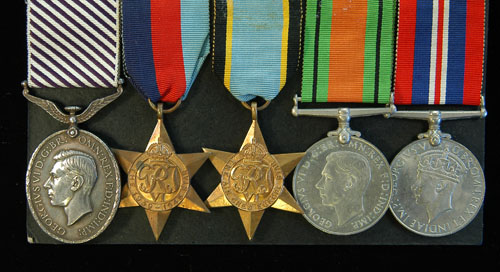
Auction: 6007 - Orders, Decorations, Campaign Medals & Militaria
Lot: 379
An ´Immediate´ 1940 Bomber Command D.F.M. Group of Five to Hampden Air Gunner and Observer Sergeant H. Wathey, No. 144 Squadron, For Conspicuous Gallantry near Munich after His Aircraft had Been Crippled by Flak; With One Engine Stopped and the Rudder Control Unserviceable, He Remained with His Guns Attempting to Eliminate the Enemy Searchlights; He later Assisted His Captain to Steady the Aircraft from an Almost Uncontrollable State and Helped Coax the Hampden to Limp Over 100 miles to Enable the Crew to Bale Out Over Firendly Territory; He was Killed in Action, February, 1942 During the Attack on the German Capital Ships, Scharnhorst, Prinz Eugen and Gneisenau, He and his Crew Were Lost Without Trace Distinguished Flying Medal G.VI.R., 1st ´Ind: Imp:´ type (563289. Sgt. H. Wathey. R.A.F.); 1939-45 Star; Air Crew Europe Star; Defence and War Medals, nearly extremely fine (5) Estimate £ 2,200-2,500 D.F.M. London Gazette 31.5.1940 563289 Sergeant Herbert Wathey No. 144 Squadron The Recommendation, dated 19.5.1940, states ´For conspicuous gallantry and devotion to duty when Air Gunner and Observer of an aircraft engaged in an attack on a target at Glanbach-Rheydt on the night of 11th/12th May 1940, when the aircraft was hit at least five times and was badly damaged, one engine stopped and the rudder controls shot away. He remained at his post firing on searchlights with his machine guns and succeeded in putting two out. When the aircraft was almost uncontrollable and was describing complete turns, he went to the assistance of the pilot and helped him to maintain full left bias on the rudders to enable him to keep on a straight course. By his coolness and courage, he materially assisted in the flight of over 100 miles which enabled the crew to abandon the aircraft over friendly territory. Strongly recommended for the award of the Distinguished Flying Medal.´ Flight Officer Herbert Wathey, D.F.M., born Nottingham, 1912; joined as Aircraft Apprentice Royal Air Force, 1929; posted Air Observer 144 Squadron, Hemswell, Lincolnshire (Hampdens), 1940; flew in operational sorties including: raids over Denmark and Norway; Munich, 11.5.1940 (see Recommendation), when on the return leg in Hampden I PI326 PL, piloted by Wing Commander Luxmoore, after flying for an hour after the aircraft had been hit and virtually crippled, the pilot gave the order for his crew to bale out, all three including Wathey landed safely on the French side of the Maginot Line, returning to base two days later, whilst sadly Luxmoore died when the Hampden crashed near Finnevaux (Namur); Dortmund and Ems Canal; Aerodrome at Wessel; Aerodrome at Heide; Osnabruck; Cologne; Leuna Air Refinery; Wilhelmshaven (2); Hamburg (2), including 8/9.5.1941, when Wathey was the Navigator in Hampden A.D. 901, piloted by Squadron Leader Fleming, after successfully bombing Hamburg and part of the way into the return leg, when, ´our port motor failed completely. I had noticed a few minutes before that the oil pressure had gone down to zero......aircraft not really maintaining height....jettison both sets of guns... At the same time, the navigator was instructed to jettison his bomb sight, his gun and ammunition.....280 miles to go to reach the English Coast. From that point my navigator laid out a course on which he marked our position for every 5 minutes, and by which he heartenend my crew by telling them how much longer they had to go to reach the Coast..... the Navigator was keeping track of the aircraft, he also helped the pilot to maintain steady course by casing the strain on the rudder, so that the pilot could move his right foot occasionally....... We arrived on the English Coast at Sheringham, and continued on to Bircham Newton Beacon...... the petrol gave out in the starboard engine and we had to force land..... I went through electric power lines to the farm, and broke a pole. This pole carried away half my tailplane, with the result that the aircraft had swung down on to the ground on to the port mainplane, and the aircraft swung round sharply after striking the ground. The port engine was completely wrenched from the fuselage, and the starboard airscrew was broken off at the reduction gear. The nose of the aircraft and the rear gunner´s position, and the underside of the fuselage, were completely wrecked´ (Operations Record refers), amazingly none of the crew came to any harm; Operation "Fuller", 12.2.1942, when he flew in Hampden I AT 175 PL, piloted by Wing Commander Simond, in the attack on the three capital ships of the German Fleet (Scharnhorst, Prinz Eugen, and Gneisenau) that had broken out of Brest, the Hampden took off from North Luffenham and was lost without trace> The crew of five are all commemorated on the Runnymede Memorial.
Sold for
£2,600




